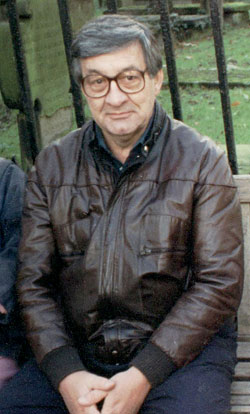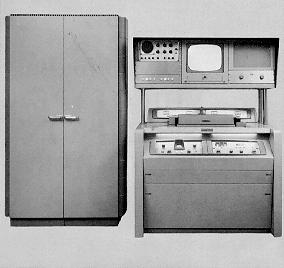Night Train Background
During the year 2007 I had the pleasure of exchanging emails with Ray F. Caldwell who engineered most of the "Night Train" sessions:

Ray Caldwell in London December 1994
Ray F. Caldwell: "I came across your website giving info on the location of WLAC-TV. It was not in the L&C Tower. It was in the building adjacent to the Tower and its address was 159 4th Ave. N. I was employed by WLAC-TV for 40 years, later becoming WTVF with employment stretching from the 2nd week of its coming on the air til my retirement in late 1994. I was the audio engineer for virtually all of the Night Train sessions. The first and last dates for Night Train airing from our station was Oct. 23, 1964 and May 27, 1967"
"All Night Train videotaping was done in the WLAC-TV studio at 159 Fourth Avenue North in Nashville, Tennessee. Equipment used were Ampex Model 1000 videotape machines and RCA TK-11 TV cameras with turret mounted lenses.
The picture is so close to the one I remember that I think I can say that it is precisely the one we used (refers to the picture below of an Ampex 1000 - webmaster). One of our machines was outfitted with an extra panel on the bridge that contained some quadrature adjustments. This could be used in case we had a video head that exhibited some "out of phase" problems and could be used to correct same. It was specified by our chief engineer, Ralph Hucaby (recently deceased) but the head quadrature was so good we never had to use it except maybe once on an out of station tape. I also believe that the accompaning rack equipment we had was not enclosed in a cabinet with doors, but had all the racks open to facilitate setup adjustments.
Microphones were RCA BK-5, 77D, BK-1, EV666, and an EV stick mike with a model number I don't recall (Edit: The EV stick mike whose model number I could not recall, I've looked up. It is an EV646. Jim Steele is a microphone guru who guided me to it.).
One problem we knew we had to solve was studio audio leaking into the announce booth. The small announce booth projected much like a bay window into the studio separated by only 2 pieces of glass. The Night Train band would certainly be easily heard anytime the announce booth mike was used. So we equipped our Ampex 350 audio tape recorder with a sub-sonic audio oscillator so that all booth announcements could be recorded in advance of Night Train taping sessions. The announcer would press a button putting on the required pulse after each announcement so the tape would stop and it would automatically be cued for the next station break or the "Back to our Million Dollar Movie" announcement. The announcers became so proficient with this technique that they could record their entire evenings announcements in a few minutes.
Most recording sessions were held immediately after the station finished the 10PM News-Weather-Sports block and we immediately started shoving the desks and props back into the corners and bringing out the various flats that would be used for Night Train.
Many sessions were held on Tuesday nights but could be most any other night if necessary including Saturday mornings. Talent availability governed scheduling. As the sets were being positioned, microphones were put out and connected and the one and only audio console, an 8 input single channel General Electric was configured for Night Train. No reverb or EQ was used. None available.
Talent would start coming in and the studio crew would continue positioning lights, guitar amps. I think the piano was a grand and Bob Holmes, the Night Trains musical director would play so that his face could not be seen. Something about accommodating the musicians union I think. After some rehearsal and talent changing into their stage clothes, we'd get video and audio mix levels. The videotape engineer usually loaded up 90 minute reels of 2 inch tape on the Ampex VT recorder. Camera control would adjust the picture levels while communicating with the lighting director to solve any problems that might come up. As soon as everyone was ready, we'd roll VT to record and be underway.
At this point we're recording separate songs only, each one being identified on a slate board. We'd tape one after another giving talent and crew time to work out any problems, music or technical. This would go on for the several hours available which would take us into the wee hours of the morning. The videotape engineer would allow plenty of space between songs on the videotape so that he could later cut the tape up so that each song could be put on an individual small reel. We had to allow plenty of time before the song started so that when played back we would anticipate Nobles introduction by 8 seconds as that was the length of time it took for a videotape to fully stabilize before going to air, or actually to another tape. That brings up how the individual hour long programs were assembled. Days later, whenever we could clear studio time, Noble would sit at the "nightclub table" in front of a rear screen projector which was loaded with a slide of a nightclub scene. Since we only had two VT machines, we would use one for recording the program, and the other for playing back the previously recorded songs. Noble would ad lib until he got a cue that the next song was ready for playback and then he would give an 8 second lead-in so the VT would come up right on time. Other times he would give a cue for a commercial break that would be used by other stations playing the program to insert their own commercial spots. Fortunately the opening and closing for Night Train was on SOF (sound-on-film) which gave the videotape engineer a chance to catch his breath. In checking with the videotape engineer the other day, (he is now 82), he reminded me that there may have been the rare occasion when a physical splice might have to be made. This was an especially exacting procedure involving special training and equipment that not everyone had the patience to learn.
Noble's niece was my companion in the small audio booth. Noble had asked me if she could sit with me so she would be out of the way (she was about 10 years old I think), and that way she could see and hear everything that was going on. She remembered me and as a grown up young woman asked me to be one of the eulogists at Noble's funeral. I felt very honored. Bob Holmes played piano at the funeral. I forget the piece he played (I'm 78) but he played it in every conceivable style you can think of. I'm glad along with the rest of the TV crew to have been a part of Night Train."
"No pre-recorded backing tracks were ever used and any applause was cross-faded from a 78 rpm ET that we had especially cut by an engineer on the third floor of our building which housed the WLAC radio studios. One of their engineers would run cables down to our restrooms on the first floor to use for reverb. The Singing Speer Family Golden Anniversary album comes to mind particularly. I digress. There was never any studio audience. Just other performers waiting their turn.
Just as an aside: There were rare occasions when we were not sure of a guests gender. We had no dressings rooms as such, just the mens and womens restrooms. Choice of which to use was left up to them. Not everyone had an entourage. Gladys Knight and her Pips were an exception. Very cool and laid back. I'm wondering if they ever made it to a program tape. I can't recall.
All recordings were made to videotape. No audio tape recordings were ever made except when I may have experimented with slapback. I belive I used the better part of wisdom and didn't do that! We didn't do multiple takes of songs. My recollection is that we'd rewind the VT and and try again. There would be no spare time for going back and sorting out takes.
I can't end these "ramblings" about Night Train without mentioning Ironing Board Sam. Sam was a gifted performer on a keyboard he had mounted on a Sears Roebuck ironing board. The electronics were a small mountain of the most nondescript electronic cast-off chassis all just barely wired together to provide a very serviceable sound but with frequent interruptions to silence the inevitable buzz or hum. Sam would move a few components with his foot and we'd re-roll videotape to record. Sam hauled everything around in a pink Cadillac sedan with matching pink trailer for his equipment. This was a familiar sight parked in the alley next to our studio. I understand Sam is still performing. We should all be so lucky!"
The help of Lucy Ray in jogging the memories of Night Train and pointing me in appropriate directions is sincerely appreciated.
Ray
Night Train Personnel
Producers
Noble Blackwell
Bill Williams
Director
Joe Hostettler
Cameras
Joe Rohelier
Leonard Montgomery
Ronnie Merville
Ronnie Smith
Jim Norton
Mike Turner
Camera Control
Julian Tompkins
Cliff Boswell
Lighting
Mike Turner
Audio
Ray Caldwell
Al Pachucki
Videotape
Reed Skinner
Cliff Boswell

















